HORIKAWA, Kazuki D. Sc., Associate Professor
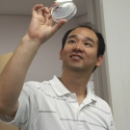
- Multicellular Society Laboratory, Horikawa Group
- born in 1973 Present Post (since 2010) Associate Professor, Research Institute for Electronic Science, Hokkaido University, Japan / Postdoctoral Fellow (later Research Assistant), School of Science, The University of Tokyo, Japan / Ph.D., Graduate School of Science, Kyoto University, Japan
Awards: Young Scientists’ Prize, Ministry of Education, Culture, Sports, Science and Technology, Japan (MEXT), 2007
Hobbies: Mountain Hiking
What principle governs the coordinated behavior of social amoebae?
Living organisms show coordinated behaviors at various levels: molecules function as a super-molecular complex, cells gather to form an organ and individuals assemble to organize a society. What mechanisms organize the collective behaviors? To answer this question, it is necessary to analyze the system as a whole, instead of taking a reductive approach in which systems are dissociated into non-dynamical elements. Associate Professor Kazuki HORIKAWA and his group are trying to elucidate the rules of a cellular society through a circulatory approach of measurement, modeling and validation, using an attractive model organism, social amoeba.
- Principle that gives rise to coordinated behavior
- When I visited Dr. Horikawa in his laboratory, he took out three identical metronomes in front of me.
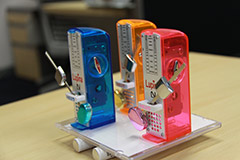 “Set their rhythm at the same frequency, and start them all at the same time,” he said. I did as instructed and set the three metronomes in motion. Tick-tack, tick-tack… the pendulums oscillated at the same rhythm. However, their rhythms gradually deviated, despite the identical setting.
“Set their rhythm at the same frequency, and start them all at the same time,” he said. I did as instructed and set the three metronomes in motion. Tick-tack, tick-tack… the pendulums oscillated at the same rhythm. However, their rhythms gradually deviated, despite the identical setting.
“This happens because of minute differences in their parts and assembly. Due to the mechanical differences, their rhythms will never remain the same. But there’s a way to realign them. Can you guess how?”- Dr. Horikawa then laid two felt-tip pens on the table and placed a plate over them. The plate became a platform that swayed on the pens acting like rollers. He put the three metronomes on this platform and started them. They went tick-tack on the swaying plate… and strangely, the movements of the pendulums became totally synchronized, striking one identical rhythm!
- “This phenomenon is called phase synchronization. The oscillation of one pendulum is transmitted to the others via the sways of the plate. The other pendulums catch the movements and start oscillating likewise, sending back the movements. As a result, all the pendulums eventually oscillate synchronously.”
- Dr. Horikawa says that he is strongly intrigued by the principle that exists behind such a phenomenon.
- “My research is motivated by my interest in biological rhythms. When “cells” that beat rhythms gather together in a large number, they give rise to coordinated patterns, forming a heart, brain or human society. I want to elucidate the principle that governs this phenomenon, and what it means to living organisms.”
- Exploring the rule of interaction that makes a group of individuals function as a whole
- Examples of biological rhythms include circadian rhythms, brainwaves, heartbeats, cell division cycle, and so on. When cells with such rhythms assembled, various phenomena occur. For example, individually, myocardial cells pulsate at random, but as a whole they constitute an organ, the heart, and realize regular blood circulation. A single nerve cell merely fires at the reception of a signal and relays it to another cell. On the other hand, a large number of neurons working together as a brain can perform far more advanced functions.
- “When the spectators in a football stadium get excited, they do waves. Tens of thousands of fireflies start to flash simultaneously. These collective phenomena are like a precision machine that cannot function normally when even a single component is removed. There’s no other way to understand them. Thinking about these phenomena, I have come to have a strong desire to carry out research that addresses the question about how coordinated behavior is affected when only the rule of interaction is modified, with all the constituent elements working normally. In other words, I want to elucidate the principle of coordinated behavior by handling the components that work as a whole without disassembling that whole.”
- Social amoeba, a treasure house of coordinated behavior
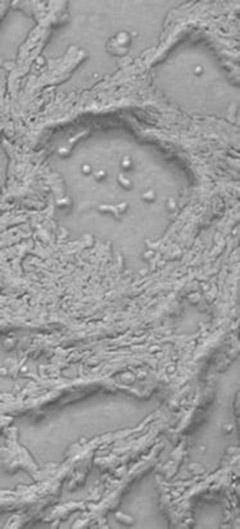 Dr. Horikawa’s group conducts research using social amoebae, unicellular organisms found in ordinary forests, such as Dictyostelium discoideum (“slime mold”) and Dictyostelium rosarium. When the quantity of available bacteria, on which the amoebae feed, reduces, about 100,000 of them get together, become multicellular, and produce spores in collaboration.
Dr. Horikawa’s group conducts research using social amoebae, unicellular organisms found in ordinary forests, such as Dictyostelium discoideum (“slime mold”) and Dictyostelium rosarium. When the quantity of available bacteria, on which the amoebae feed, reduces, about 100,000 of them get together, become multicellular, and produce spores in collaboration.
“Unicellular amoebae assemble when their survival is in danger and behave in coordination to overcome the crisis. They search for a place ideal for spore generation and migrate together. Finally, they produce spores and their supports. The cells that end up as spores are lucky ones that leave their genomes to the next generation, while the other cells must eventually die. This is a serious affair – winning or losing the chance of securing your progeniture – and fierce competition among the cells is also part of the coordinated behavior.”
Social amoeba is indeed a treasure house of coordinated behavior.
“I think that research about these coordinated phenomena with “intercellular interaction” as the key phrase will shed light on the whole spectrum of mysterious coordinated behavior. In addition to the pattern formation mechanism, which intrigues me most, our understanding of human society should also improve.”- Making inter-cellular communication visible
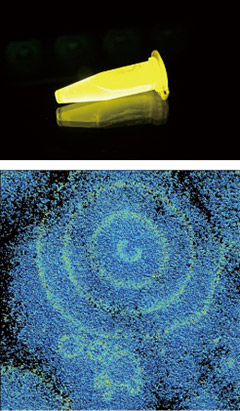 Communication of amoebae is realized when a substance called cAMP is released from a cell, another cell receiving it also synthesizes and releases cAMP, and a chain of cAMP reception/release is formed. In this process, the concentration of calcium ion in the cells changes. To observe this, Dr. Horikawa developed a Bio-sensor named “Chameleon-Nano,” which is capable of detecting extremely low Ca2+ ion concentration changes.
Communication of amoebae is realized when a substance called cAMP is released from a cell, another cell receiving it also synthesizes and releases cAMP, and a chain of cAMP reception/release is formed. In this process, the concentration of calcium ion in the cells changes. To observe this, Dr. Horikawa developed a Bio-sensor named “Chameleon-Nano,” which is capable of detecting extremely low Ca2+ ion concentration changes.
“This tool has enabled me to observe something completely new: the spatio-temporal patterns of communication of the social amoebae are not limited to regular ones such as concentric circles and spiral waves; waves spring out from everywhere; there are firework-like brilliant flashes that may be locally exchanged whispers. I saw for the first time the self-organized society of cells as it is, clearly and realistically.”- Approaching the truth by alternating experiments and computer simulation
- To understand a group as a whole, Dr. Horikawa relies on computer simulation as well.
- “Coordinated social behavior is extremely complex. A cell influences its adjacent cell through interaction. The adjacent cell then responds back to the original cell. It is possible to anticipate how this process will evolve one or two steps ahead. But when this chain of interactions goes on forever? What will happen when numerous cells are involved? I can’t keep on imagining with my limited abilities. But this complex process can be reproduced by identifying simple rules of interaction based on actual measurements and simulating with the computer. Moreover, it is possible to simulate many different scenarios in virtual reality, modifying the rules and artificially creating a leader cell. Then, we can test findings from simulations in experiments using actual cells. My wish is to clarify some important message that must be there, at the bottom of a self-organized society where simple communication takes place, by alternating experiments and computer simulations in this way.”
- Greater variety in communication
- At present, Dr. Horikawa is working on the development of a new tool that will make communication visible.
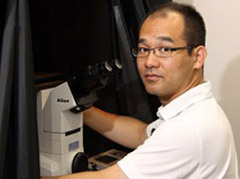 “The research currently in progress concern only simple systems that can be likened to Japanese-only or American-only communities. But when different cultures interact, we can expect something new to come out as a result. I suppose that in nature a variety of amoebae form a complex society and engage in coordinated activities for their survival. Therefore, I hope to be able to manipulate and make visible not only intra- but also inter-species communication. If cells that are at the boundary of two groups function as “interpreters,” this may give rise to a new collective order. I hope to experiment this type of evolution in cellular society using amoebae.”
“The research currently in progress concern only simple systems that can be likened to Japanese-only or American-only communities. But when different cultures interact, we can expect something new to come out as a result. I suppose that in nature a variety of amoebae form a complex society and engage in coordinated activities for their survival. Therefore, I hope to be able to manipulate and make visible not only intra- but also inter-species communication. If cells that are at the boundary of two groups function as “interpreters,” this may give rise to a new collective order. I hope to experiment this type of evolution in cellular society using amoebae.”- (Interviewed by Yoshiko Tamura 2011)
















